The week at a glance
- Long-toed Stint in East Sussex
- Solitary Sandpiper, Black-and-white Warbler, Northern Waterthrush and Baltimore Oriole on Scilly
- Lesser Kestrel in Orkney
- Short-toed Eagle in Jersey
- Swainson's Thrush on Shetland
- American Black Tern in Lincolnshire
- Probable Sandhill Crane in Lothian, Northumberland and Norfolk
- Possible Black-bellied Storm-petrel off Somerset
- Possible Azure Tit in Buckinghamshire identified as an escaped Yellow-breasted Tit
- Hudsonian Whimbrel in Co Cork
- Buff-bellied Pipit in Outer Hebrides
- Little Shearwater in Co Mayo
- Probable Yelkouan Shearwater off North Yorkshire
- Black Scoter still in Aberdeenshire
- Albatross sp. off Dumfries & Galloway
Many will hope that the arrivals this week are a sign of things to come. Scilly returned to the fore as the destination of choice for Nearctic vagrants, and the emphasis shifted from waders to mouth-watering passerines.
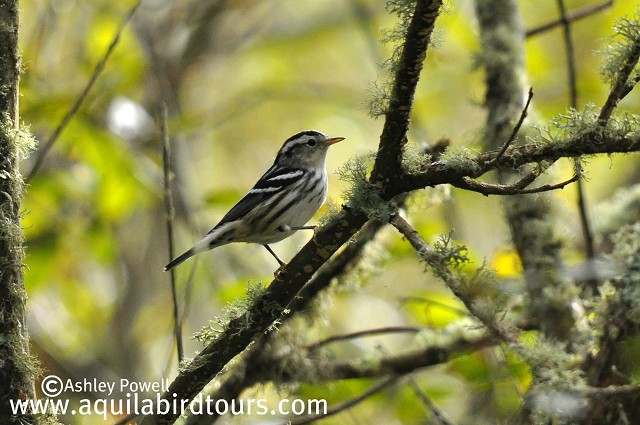
Black-and-white Warbler, St. Mary's, Isles of Scilly (Photo: Ashley Powell)
At sea, conditions were still good for the west coast, and the highlights were numerous and bizarrely all on 18th. The most frustrating was an unidentified petrel that lingered off Minehead (Somerset) briefly in the morning. This bird was noticeably long-winged and showed a dark rump and clean white underparts extending onto the breast. Black-bellied Storm-petrel was originally mooted, but this seems less likely now. While the location of this record may seem rather unexpected, the previous record of a possible Black-belled Storm-petrel was just further up the estuary off Severn Beach (Glos) in November 2009. Further north still, an unidentified albatross was seen from a fishing boat off Barlocco Isle (Dumfries & Galloway), and in Ireland a Little Shearwater was off Kilcummin Head (Mayo) (along with two Great Shearwaters, 15 Leach's Petrels and 12 Grey Phalaropes). In the east, a probable Yelkouan Shearwater was reported past Long Nab (North Yorks), this time on 15th.

Leach's Storm-petrel, Kilcummin Head, Mayo (Photo: Derek Charles)
Apart from an escaped Lesser White-fronted Goose at North Cave Wetlands (East Yorks) on 18th, the only wildfowl of note was the drake Black Scoter again off Blackdog (Aberdeenshire) on 18th.
The first of two notable raptors this week was a Short-toed Eagle at Vallee des Vaux Trinity (Jersey) on 20th, which follows a juvenile on nearby Guernsey in June 2006. Almost as notable, though no more accessible for most, was a small raptor on North Ronaldsay (Orkney) on 20th that was later identified as a first-summer male Lesser Kestrel. It remained to 21st and is the first record for Orkney and only the third for Scotland, following a male on Fair Isle in June 1987 and a female shot at Boyndlie (Aberdeenshire) in October 1897.

Lesser Kestrel, North Ronaldsay, Orkney (Photo: anon)
Following the "is it or isn't it" Red-necked Stint at Weir Wood Reservoir (East Sussex) earlier in the month, there was some scepticism over the claim of an odd-looking Temminck's Stint there this week. After it had been present for six days, thoughts turned to Least Sandpiper, but by 21st these thoughts had been upgraded to Long-toed Stint. Although showing only distantly (viewing will generally be at a good 600m!), the ID seems good and this is a hell of a blocker: the last twitchable bird was at Ballycotton (Cork) in June 1996 and for those with a purer British list, Saltholme (Cleveland) in August 1982. Apart from these two records, the only other was at Marazion (Cornwall) in June 1970.

Long-toed Stint, Weir Wood Reservoir, East Sussex (Photo: Mickd)
The place to be this week was Scilly, though, with a hatful of major rarities for those tempted to make the trip. The Solitary Sandpiper remained at Newford Duckpond (St Mary's) all week, as did a Blue-winged Teal, but the real highlights were passerines. A probable Northern Waterthrush at Lower Moors (St Mary's) on 16th was eventually confirmed the next day and remained all week, though it was elusive and skulking. There are nine previous records, and this is the fifth on the Isles of Scilly, though the first on St Mary's. The last twitchable bird was back in 1996 at Portland (Dorset), so this was the perfect start to the Scilly season. Those searching for this bird must have been pretty surprised to also find a female Black-and-white Warbler in the same area on 17th, which also remained to at least 20th. There are four previous records of this humbug of a warbler on Scilly, the last on Tresco in October 1996. This is also a rather early bird, with just two earlier records. As if this fantastic trio of birds that harked back to the heyday of Scilly wasn't enough, a first-winter female Baltimore Oriole was on The Garrison (St Mary's) on 20th–21st. This is the earliest ever autumn record and, once again, Scilly remains the place to see such species: six of the 24 previous records come from the islands. To add to the supporting cast, the Red-eyed Vireo also remained around The Garrison to at least 19th and another or the same was at Porth Hellick on 21st.
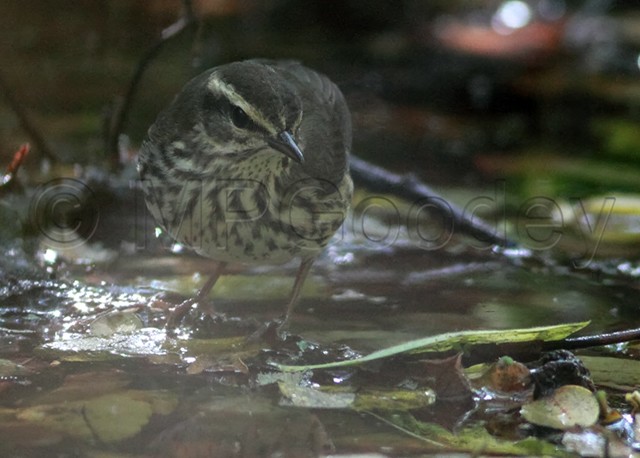
Northern Waterthrush, St. Mary's, Isles of Scilly (Photo: Martin Goodey)
Northern Waterthrush, St. Mary's, Isles of Scilly (Video: benjimi1)

Black-and-white Warbler, St. Mary's, Isles of Scilly (Photo: Ashley Powell)
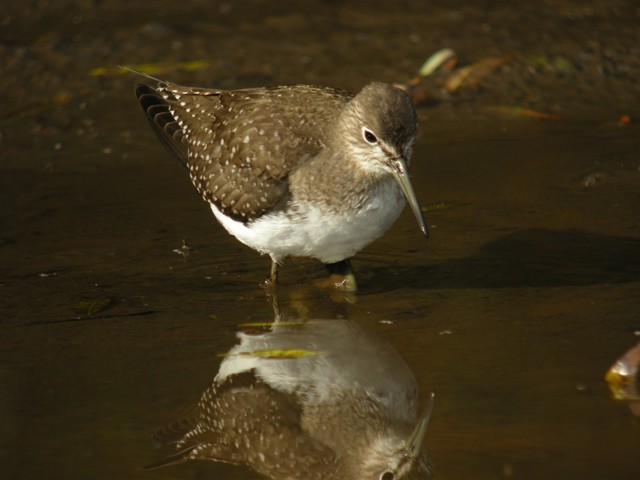
Solitary Sandpiper, St. Mary's, Isles of Scilly (Photo: Scott Mayson)
Solitary Sandpiper, St. Mary's, Isles of Scilly (Video: benjimi1)

Baltimore Oriole, St. Mary's, Isles of Scilly (Photo: Martin Goodey)
Another tantalising report this week concerned the appearance of a probable Sandhill Crane. First noted heading south over Dunbar (Lothian) on the morning of 16th, it was then seen over the A1 at Berwick-upon-Tweed (Northumberland) two and a half hours later and also reported over West Walton (Norfolk) on the afternoon of 17th. These sightings could relate to the same bird as seen recently in Finland and Estonia but, considering the recent run of western arrivals, it could well be a second bird.
As if encouraged by the recent splitting recommendations from the Taxonomic Sub-Committee of the BOURC, Ireland's third Hudsonian Whimbrel put in an appearance at Three Castles Head (Cork) on 20th–21st. But another race seemingly not destined to be split any time soon is American Black Tern, so a juvenile at Covenham Reservoir (Lincs) on 17th–21st will remain as an armchair tick of the future for those making the trip.
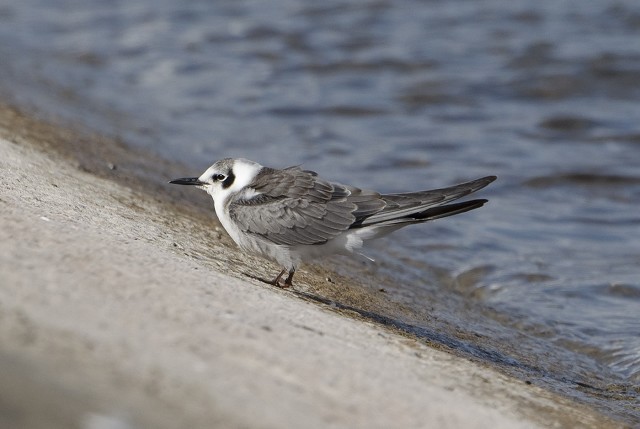
American Black Tern, Covenham Reservoir, Lincolnshire (Photo: Graham Catley)
Perhaps a more expected Nearctic passerine these days is Buff-bellied Pipit, though one on St Kilda (Outer Hebrides) on 18th was hardly twitchable. Also on the remote island were a White-rumped Sandpiper, Pectoral Sandpiper and four Yellow-browed Warblers. Shetland finally also caught up with the Nearctic autumn late in the week with the finding of a Swainson's Thrush at Boddam on 21st. September birds are rather unusual, with just four previous records, though this is the earliest by six days.
A couple of unconfirmed reports received during the week concerned Bridled or Sooty Tern past Southwold (Suffolk) on 15th and a possible Isabelline Wheatear in Richmond Park (London) on 16th.
Last, and in many respects least, one bird that doesn't make it onto the list of megas but caused quite a stir nonetheless was a putative Azure Tit visiting feeders in a Buckinghamshire garden. Noted by the householder two weeks earlier, it reached the attention of local birders late last week. While some liaised with police and villagers in anticipation of the expected mass arrival of twitchers, others set to work examining photographs of the bird. Various plumage anomalies had been noted early on, and it probably came as a positive relief to the residents of the quiet village of Naphill when the bird was found to be a Yellow-breasted Tit that had escaped from a local aviary: an educational bird, nonetheless.
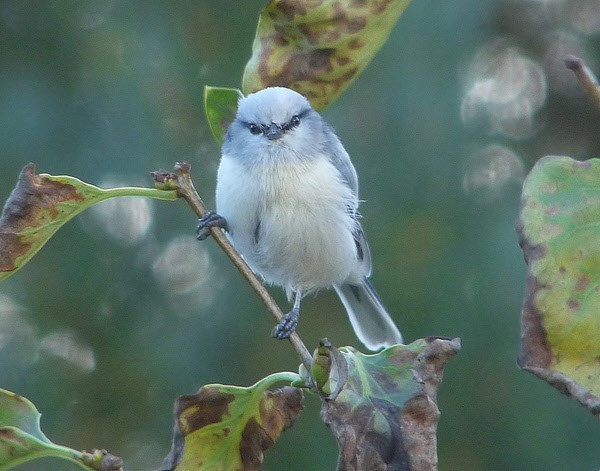
Yellow-breasted Tit, Buckinghamshire (Photo: David Ferguson)
The four Snow Geese from East Chevington (Northumberland) flew over nearby High Hauxley on 18th in the company of 40 Pink-footed Geese, and it'll be interesting to see whether they stick with these birds into the winter. The only Ruddy Shelducks reported were one still at Abberton reservoir (Essex) to 19th and two drakes and a female at Pentney Gravel Pits (Norfolk) on 20th.
There was finally a slightly better showing of Nearctic wildfowl this week. New drake American Wigeon were at Wellington Gravel Pits (Herefordshire) on 16th–19th and Loch Bee, South Uist (Outer Hebrides) on 18th–20th, with a further possible on the Hayle Estuary (Cornwall) on 18th. The eclipse drake Blue-winged Teal remained at Saltholme (Cleveland) to 17th, also seen at Haverton Hill on 16th, and new juveniles were on St Mary's (Scilly) and at Shannon Airport Lagoon (Clare) on 18th. There were fewer Ring-necked Ducks, though; one was still at Chew Valley Lake (Somerset) to at least 20th and two new drakes were at Loch Kinord (Aberdeenshire) on 18th. The drake Ferruginous Duck also remained at Chew Valley Lake (Somerset) all week and the drake Black Duck remained around Achill Island (Mayo).
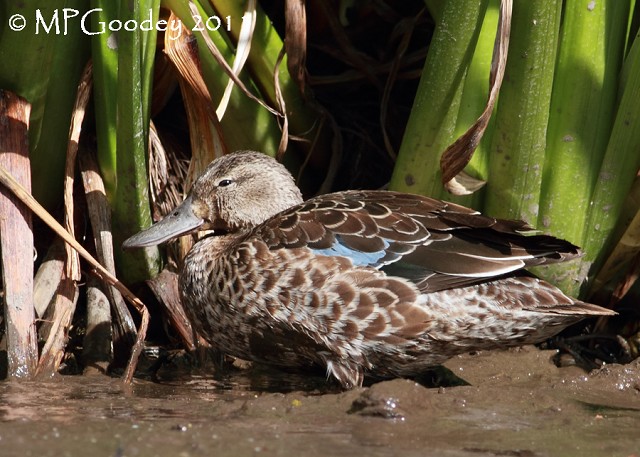
Blue-winged Teal, St. Mary's, Isles of Scilly (Photo: Martin Goodey)
There were further reports of some notable seabirds in the North Sea, including a Fea's Petrel past Lowestoft (Suffolk) on 15th, presumably the same as that seen passing Frinton-on-Sea (Essex) and Sheringham (Norfolk) the next day. There was then a further report of a distant "possible" past Cley Marshes (Norfolk) on 19th. Interestingly, and unexpectedly, most Cory's Shearwaters were also reported from east-coast sites as far north as Dunbar (Lothian), whilst in the west the only reports were of birds off Porthgwarra and Bass Point (Cornwall). There was a good run of records in Suffolk and Essex, including two past Kessingland (Suffolk) on 16th. Seawatchers there also recorded two Great Shearwaters the same day; possibly the same birds were seen off Southwold and Landguard, and one was also off Flamborough Head (East Yorks) on 15th. In the west, there were two off Seven Heads (Cork) on 17th and nine off Cape Clear (Cork) on 19th. There were also some very notable counts of other shearwaters, including 283 Balearics past Porthgwarra (Cornwall) on 18th and 1360 Sooties past Bridges of Ross (Clare) on 16th, along with 35 Long-tailed Skuas. Other large counts of Sooties included 1100 past Dursey Island (Cork) on 18th and over 400 headed east past Lossiemouth (Moray & Nairn) in just four hours on 18th.
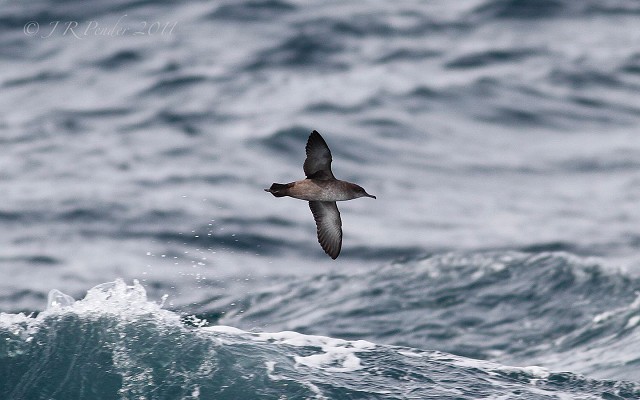
Balearic Shearwater, Scilly pelagic (Photo: Joe Pender)

Sooty Shearwater, Northumberland (Photo: Steven Fryer)
Small numbers of Wilson's Storm-petrels continued to be seen: singletons were off Pendeen (Cornwall) on 17th and 18th, Brandon Point (Kerry) on 18th and Bridges of Ross (Clare) on 17th, with two on 18th. More notable, though, were the continued exceptional numbers of Sabine's Gulls and Grey Phalaropes. Of the former, 392 were seen off Bridges of Ross (Clare) on 16th, with a massive 865 the next day, and 'smaller' counts on 18th of 39 past Pendeen, 18 past Strumble Head (Pembrokeshire) and 18 off Ramore Head (Antrim). There were also several windswept inland birds, the most notable being the adult still at Grafham Water (Cambs) all week and juveniles at Leadenham (Lincs) on 16th–19th and Belvide Reservoir (Staffs) still to 15th. Grafham also hosted two Grey Phalaropes, and reports of this species were widespread as far north as Workington (Cumbria). Numbers peaked at 120 past Bridges of Ross on 17th, 20 past St Ives (Cornwall) on 18th (along with a single Red-necked Phalarope) and 17 past Pendeen on 17th. Notable inland records besides Grafham included one at Kingsmill Reservoir (Notts) on 15th and three at Chew Valley Lake (Somerset) on 15th.
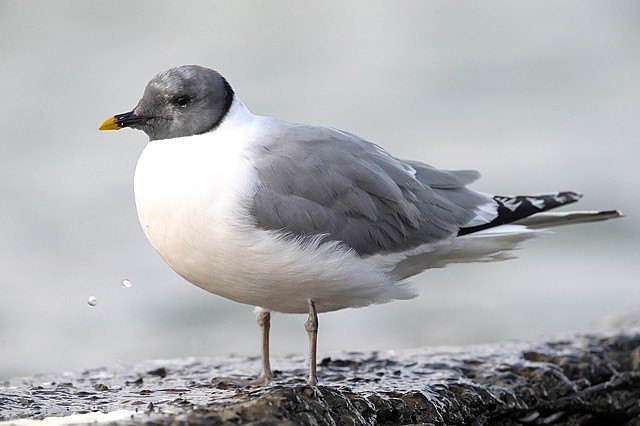
Sabine's Gull, Grafham Water, Cambridgeshire (Photo: Ian Curran)

Grey Phalarope, Prinstead, West Sussex (Photo: Russ Tofts)
There were single reports of Purple Heron (a bird with Grey Herons at Les Tielles, Guernsey, on 16th) and White Stork (a bird photographed at Maw Green Landfill Site in Cheshire on 18th). The regular Great White Egrets remained at Dungeness (Kent) and Meare Heath (Somerset), with further new birds at Salthouse Point (Glamorgan), Linford NR (Bucks), Frodsham Marsh (Cheshire), Otley (West Yorks) and Long Drag (Cleveland). The Cattle Egret also remained at Thorney Island (West Sussex), with new birds over Ipswich (Suffolk) on 17th and at Wall Common (Somerset) on 17th–19th. The second Squacco Heron of the year was at Studland Heath (Dorset) briefly on 21st. Spoonbills were widespread as expected, with double-figure counts including 18 at Boyton Marshes (Suffolk) and 16 at Wych Lake and Brownsea Island (Dorset).

Squacco Heron, Studland Heath NNR, Dorset (Photo: Gwenda Yeomans)
To resolve any confusion over the number of Black Kites currently residing in Cornwall, there were three together at Polgigga on 15th–16th, two of which remained in the area to the end of the week. Any number of Pallid Harriers continued to be seen at numerous sites around Shetland this week and one also remained at Tacumshin (Wexford) all week. Also in Scotland, a juvenile was photographed at Pennyghael, Mull (Argyll) on 20th and there were further "possibles" at Loch of Strathbeg (Aberdeenshire) on 18th and at Barns Ness (Lothian) on 19th. Following Oxfordshire's first last week, what could possibly be the same juvenile was seen near Burpham (West Sussex) on 17th–21st, also a first for the county. There was then a further juvenile at Colne Point (Essex) on 17th–18th, and possibly again at Marsh Farm CP on 20th, the second for the county following one in June 1993. The first Rough-legged Buzzard of the autumn was at Reculver (Kent) on 19th.
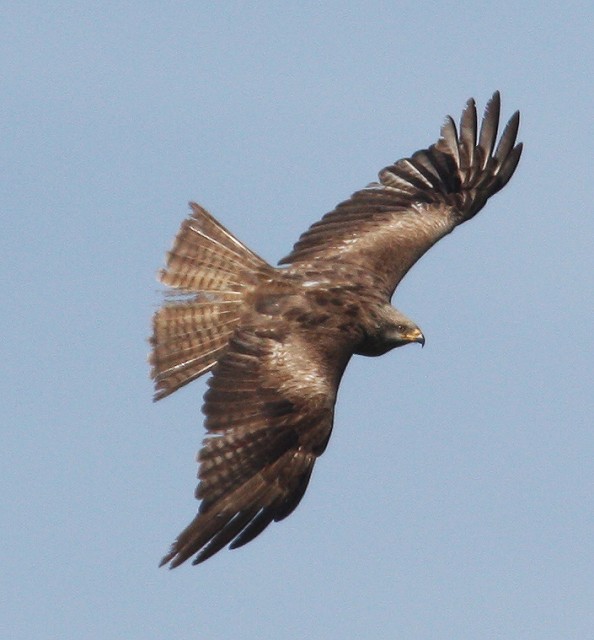
Black Kite, Polgigga, Cornwall (Photo: Adam Davison)
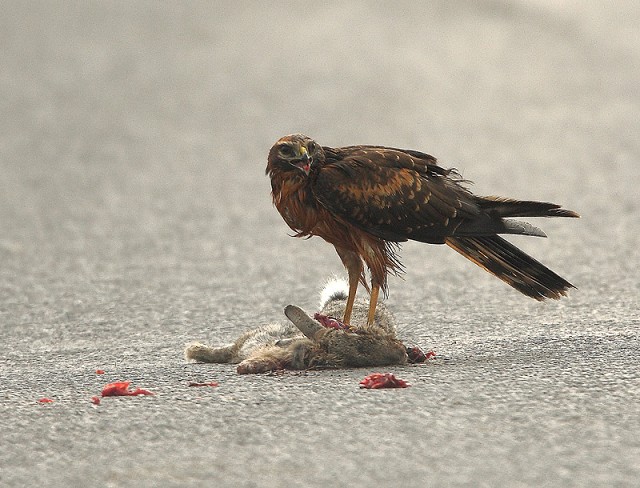
Pallid Harrier, Quendale, Mainland, Shetland (Photo: James Wood)
The Spotted Crake remained at Inner Marsh Farm (Cheshire) to at least 15th. Five American Golden Plovers this week were all in Ireland: at Tacumshin (Wexford) to 19th and new birds at Carrahane Strand (Kerry) on 15th, Kilcoole (Wicklow) on 16th, Black Rock Strand (Kerry) on 19th–20th and Achill Island (Mayo) on 21st.
In Cornwall, a Lesser Yellowlegs was at Tresemple Pool on 21st and one or the same remained at Drift Reservoir to at least 20th, with the juvenile Semipalmated Sandpiper there to 16th. A juvenile Spotted Sandpiper was also reported there on 15th, though this was never confirmed. A more certain bird remained on the Plym Estuary (Devon) all week and the long-overdue first for Gloucestershire was a juvenile at Lydney on 15th–19th. The Long-billed Dowitcher at Stithians Reservoir (Cornwall) also remained to 19th, with further juveniles reported from Baron's Haugh (Clyde) on 17th–21st and Oare Marshes (Kent) on 18th.

Lesser Yellowlegs, Drift Reservoir, Cornwall (Photo: Mark Worden)
Lesser Yellowlegs, Drift Reservoir, Cornwall (Video: chippler01)
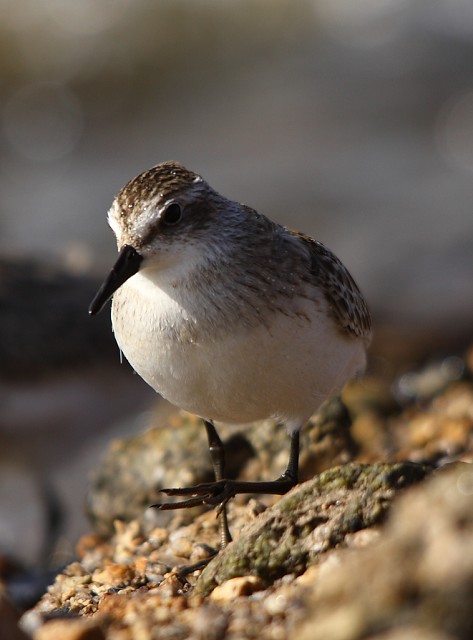
Semipalmated Sandpiper, Drift Reservoir, Cornwall (Photo: Chris Griffin)

Spotted Sandpiper, Lydney, Gloucestershire (Photo: Mick Colquhoun)
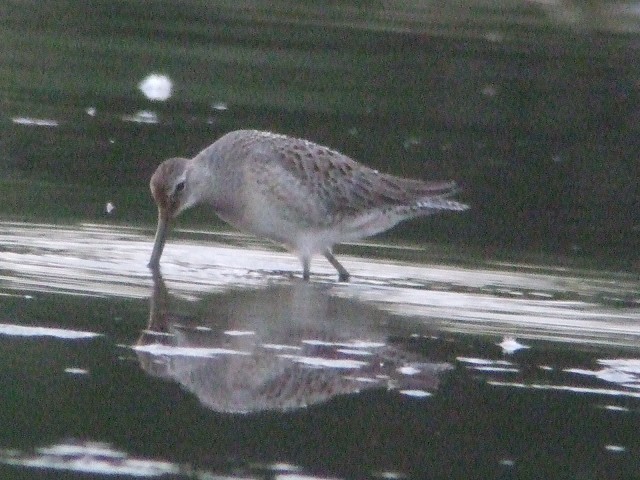
Long-billed Dowitcher, Baron's Haugh RSPB, Clyde (Photo: D Abraham)
Long-billed Dowitcher, Stithians Reservoir, Cornwall (Video: chippler01)
Semipalmated Sandpipers were remarkably well spread, with birds at up to 12 sites in Ireland including four juveniles at Achill Island (Mayo) on 21st. This side of the Irish Sea, birds were at Chew Valley Lake (Somerset) to 18th, Slimbridge (Glos) on 18th–19th and Peninerine and Kilpheder, South Uist (Outer Hebrides) on 17th and 21st respectively. Also in Scotland, Shetland's second Least Sandpiper was on Foula on 16th–19th.

Least Sandpiper, Foula, Shetland (Photo: Dougie Preston)
White-rumped Sandpipers were also widespread: birds were reported from six sites in the Outer Hebrides, eight in Ireland, two in Cornwall (Davidstow Airfield and Devoran) and also at Newburgh (Aberdeenshire). There were far fewer Baird's Sandpipers; birds remained at Pennington Marshes (Hants) to 18th and on St Agnes (Scilly) to 18th, plus two at Downings (Donegal) on 18th. New birds were also at Tawin (Galway) on 16th, with two at Achill Island (Mayo) on 17th–21st, one at Loch Paible, North Uist (Outer Hebrides) on 21st and the first for the Isle of Man at Langness on 21st. Leam Lough (Mayo) did the double, with both Baird's and White-rumped Sandpiper there on 21st along with two Semipalmated Sandpipers.

White-rumped Sandpiper, Tiree, Argyll (Photo: John Bowler)

White-rumped Sandpiper, Corragaun Lough, Mayo (Photo: Richard Bonser)

Baird's Sandpiper, Achill Island, Mayo (Photo: Derek Charles)
Pectoral Sandpipers were still around in excellent numbers, being reported from as many as 40 sites during the week. Up to five were around the Great Pool, Tresco (Scilly), five were at Truska Marsh (Galway), four were at Tacumshin (Wexford) and four at Minsmere (Suffolk). Inland birds were notable at Crookham Common (Berks) to 15th, Pitsford Reservoir (Northants) to 17th, Chew Valley Lake (Somerset) to 18th and Beddington Sewage Farm (London) on 18th–20th. In Nottinghamshire, two remained at Collingham Pits to 18th and there were also two at Idle Valley NR (Notts) to 19th.

Pectoral Sandpiper, Beddington SF, Greater London (Photo: anon)
Buff-breasted Sandpipers were recorded from four sites in Scotland, eight in England, two in Wales and nine in Ireland. Many were singletons, but counts included an incredible 15 at Loop Head (Cork) on 15th, 14 at Tacumshin (Wexford) on 17th, four on St Mary's (Scilly) and three at Carrahane Strand (Kerry). In the east, Norfolk struggled to keep up with the wader bonanza of the west, but a Marsh Sandpiper at Titchwell briefly on 21st was a pleasant surprise and the first in the county for three years. A Wilson's Phalarope was at Douglas Estuary (Cork) on 17th–20th and another Great Snipe was on Fair Isle on 18th–20th.

Buff-breasted Sandpiper, Portnaluchaig, Highland (Photo: Jim Duncan)

Wilson's Phalarope, Douglas Estuary, Cork (Photo: Ronan McLaughlin)
Apart from the resident Glaucous Gull at Dungeness (Kent), the only other was a second-summer moulting into third-winter plumage at Exmouth (Devon). A new second-winter Ring-billed Gull was at Cardigan (Ceredigion) on 21st and the adult was again at Kinneil Lagoon (Forth) on 20th. Also in Scotland, late news emerged of a first-winter Laughing Gull photographed off Torsa Island (Argyll) on 14th. The juvenile White-winged Black Tern was again at Tacumshin (Wexford) on 15th, with new birds at Gormanstown (Meath) on 15th and Wath Ings (South Yorks) on 16th.
The male Snowy Owl was reported from Mangurstadh, Lewis (Outer Hebrides) on 16th and 17th. On Scilly, the Bee-eater remained on St Mary's all week and there was just one Hoopoe, at Newmachar in Aberdeenshire on 18th.
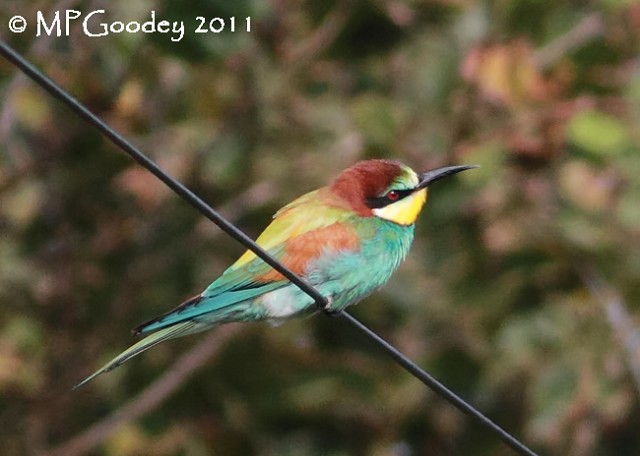
European Bee-eater, St. Mary's, Isles of Scilly (Photo: Martin Goodey)
There were plenty of records of Wrynecks along southern coasts from Winterton Dunes (Norfolk) to Newport Wetland (Gwent), and birds were also at several sites in Shetland. The only inland bird was at Horton (Glos) on 16th. There were two reports of Red-rumped Swallow, at Mizen Head (Cork) on 20th and Cley Marshes (Norfolk) on 21st, and two of Short-toed Lark, both in Shetland: a bird at Skaw, Unst on 19th and the lingering bird on Fair Isle to 20th. Fair Isle had a bit of a purple patch, with Great Snipe on 20th backed up by Citrine Wagtail, Melodious Warbler, Little Bunting, Great Grey Shrike, Short-toed Lark, five Yellow-browed Warblers and five Common Rosefinches, including a mystery colour-ringed bird. The previous day saw a Blyth's Reed Warbler ringed, along with early Redwing and Fieldfare and up to 41 Lapland Buntings.
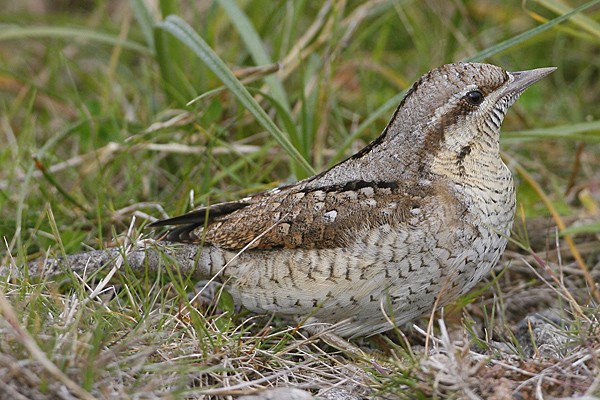
Wryneck, Newport Wetlands, Gwent (Photo: Rob Wilson)
There was a second Citrine Wagtail in the Northern Isles, at North Ronaldsay (Orkney) on 16th–20th. The island also held Tawny Pipit, two Barred Warblers, six Yellow-browed Warblers, Red-backed Shrike, Ortolan Bunting and up to five Common Rosefinches. The only other Citrine Wagtail was at Ballylongford (Mayo) on 15th–16th.
It was a better week for rare and scarce pipits, with a Richard's at Polgigga (Cornwall) on 16th and nearby a Red-throated went west over Porthgwarra on 16th. Tawny Pipits were over Noirmont Point (Jersey) and Brighton (East Sussex) on 15th and one was on Dursey Island (Cork) on 16th. The first Pechora Pipit of the year was then on Foula (Shetland) on 18th–19th, along with up to eight Yellow-browed Warblers. Incredibly, of the 83 accepted records of Pechora Pipit to the end of 2008, only 16 have been away from Shetland, and of these seven have been at Bird Observatories. So this must surely be a species that occurs in much greater numbers than the records would suggest and one worth keeping an eye (or ear) out for.
Away from the Northern Isles, the only Red-backed Shrikes were on Tresco and Bryher (Scilly) during the week, at Mizen Head (Cork) on 16th and Frinton-on-Sea (Essex) on 21st. The first few Great Grey Shrikes of the autumn also appeared, with birds at Hythe (Hants) on 18th and Fair Isle. A Lesser Grey Shrike was belatedly reported from Tollesbury (Essex) on 17th–18th, and on Scilly, perhaps two juvenile Woodchat Shrikes remained on St Mary's.

Red-backed Shrike, Bryher, Isles of Scilly (Photo: Robin Mawer)
Apart from the bird ringed on Fair Isle, other Blyth's Reed Warblers were field records: on Tiree (Argyll) on 19th–20th, at Bixter (Shetland) on 19th and on Slea Head (Kerry) on 20th. Following the removal of this species from the Irish list in 2003, this is now the fourth field record since 2007, the previous three of which are still pending with IRBC. New Melodious Warblers comprised one ringed at Trinity (Guernsey) on 15th and another at Blacksod (Mayo) on 18th–19th, and there were three reports of Icterine Warbler, at Hook Head (Wexford) on 15th, Minsmere (Suffolk) on 18th and Uyeasound, Unst (Shetland) on 19th. Yellow-browed Warblers continued to arrive en masse, despite the rather westerly airflow, with birds at many widespread sites in the Northern Isles. Elsewhere along the east coast, there were two in Aberdeenshire and birds at five sites between Holy Island (Northumberland) and Wells Wood (Norfolk). Shetland also saw Arctic Warblers at Sandwick to 18th, usefully with a Greenish Warbler, and on Foula on 18th. Barred Warblers were also widespread in Scotland, though the only English records were from Holy Island (Northumberland) on 17th–19th and Gibraltar Point (Lincs) on 15th and 18th.

Blyth's Reed Warbler, Tiree, Argyll (Photo: John Bowler)

Arctic Warbler, Sandwick, Mainland, Shetland (Photo: Hugh Harrop)

Barred Warbler, Norwick, Unst, Shetland (Photo: Mike Pennington)
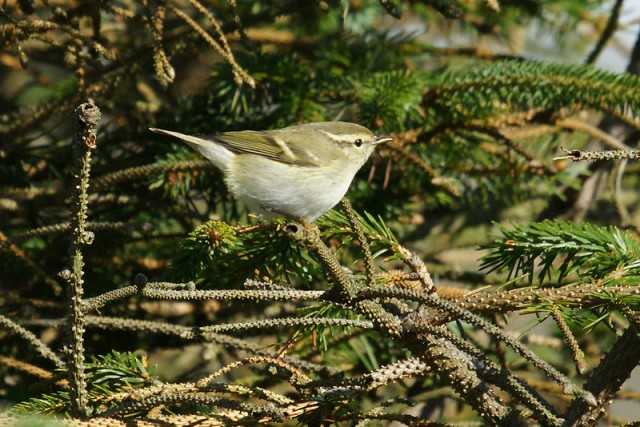
Yellow-browed Warbler, Baltasound, Unst, Shetland (Photo: Mike Pennington)
The first Red-breasted Flycatchers of the autumn arrived this week, birds at Kirkwall Airport (Orkney) on 19th and at Wester Quarff (Shetland) on 20th. Ortolan Buntings were on North Ronaldsay (Orkney) to 16th, on St Martin's (Scilly) on 19th–21st and over Galley Head (Cork) on 20th. In addition to the Fair Isle bird, a Little Bunting was on Sanday (Orkney) on 18th. Lapland Buntings were again widespread along most coasts with just one inland bird, a popular and photogenic bird at Farmoor Reservoir (Oxon) on 17th–21st. On the coast, the largest groups were 160 at Butt of Lewis (Outer Hebrides), 41 on Fair Isle, 24 at Loop Head (Clare), 20 at Balranald, North Uist (Outer Hebrides) and 16 on North Ronaldsay (Orkney).
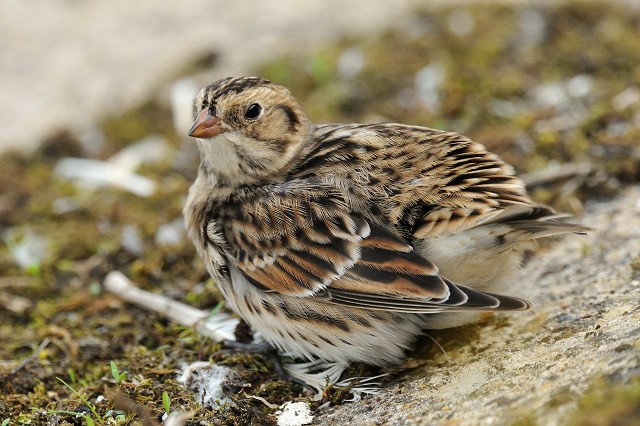
Lapland Bunting, Farmoor Reservoir, Oxfordshire (Photo: Brian Harrison)
As with most other drift migrants this week, most of the reports of Common Rosefinches came from the Northern Isles, where birds were numerous and widespread. Elsewhere, the only others were three on Cape Clear (Cork) on 16th and singletons at Loop Head (Clare) on 18th and on Tory Island (Donegal) on 20th. Last but not least, there was just one Rose-coloured Starling, on St Mary's (Scilly) on 16th.

Common Rosefinch, Baltasound, Unst, Shetland (Photo: Mike Pennington)
Photo of the Week: 15th–21st September
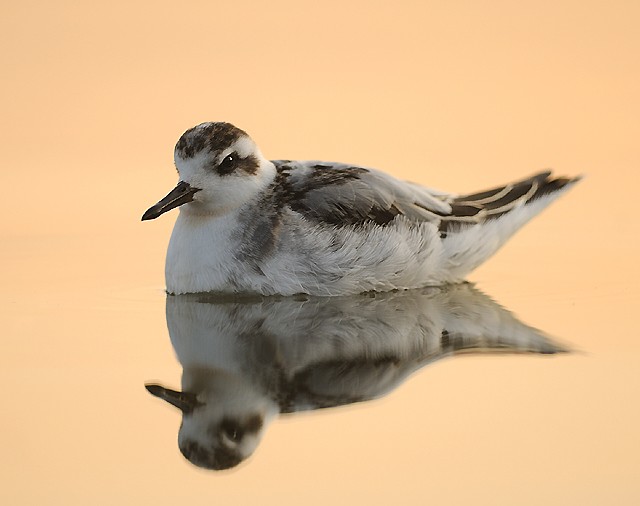
Grey Phalarope, Fairhaven Lake, Lancashire (Photo: David Moreton)
This week has been a great week to catch up with Grey Phalaropes on passage through the UK and the appearance of a first-winter bird at Fairhaven Lake in Lancashire provided one of the photo opportunities of the year. This bird stayed for at least three full days in this accessible location that allows waters-edge shooting from a variety of angles. Even better, as is often the case with this species, this bird was incredibly tame, approaching literally within inches of photographers' lenses. Decent weather and lighting conditions further ensured this was going to be a very well-photographed bird. We weren't disappointed with the results as many of our best-known photo contributors uploaded some superb images. The range of styles made it extremely difficult to pick out a single shot but, in the end, the most memorable image was David Moreton's serene portrait of the bird on calm water reflecting the warm hues of sunset. The combination of a relaxed pose, clear bird/reflection and the gorgeous apricot-coloured 'wash' makes this an image to savour. Pure art!

Common Kingfisher, undisclosed site, Kent (Photo: Tonyf)

Tawny Owl, Newton Abbot, Devon (Photo: Barry Nield)
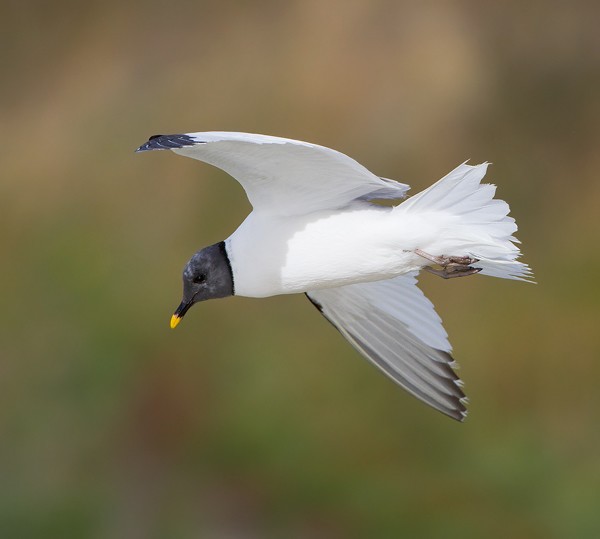
Sabine's Gull, Grafham Water, Cambridgeshire (Photo: Carl Day)

Sanderling, Thornham Point, Norfolk (Photo: Tom Hines)

Black Redstart, France (Photo: Artur Stankiewicz)
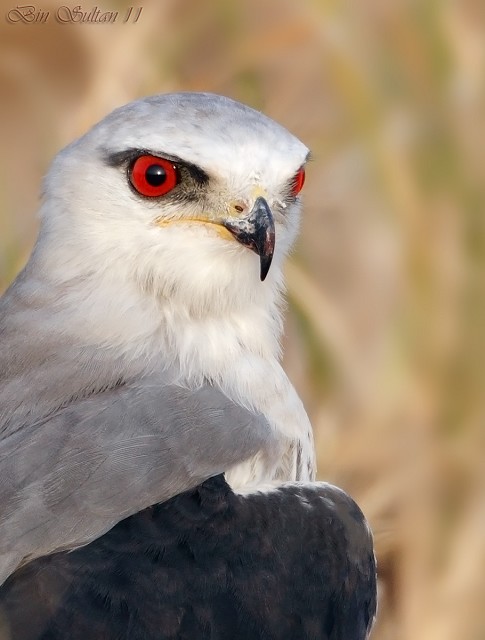
Black-shouldered Kite, Qatar (Photo: Sultan)

Little Grebe, Hungary (Photo: Eduardo Balogh)

Common Buzzard, undisclosed site, Kent (Photo: Jamie MacArthur)

Carrion Crow, Wollaton Park, Nottinghamshire (Photo: John Dickenson)
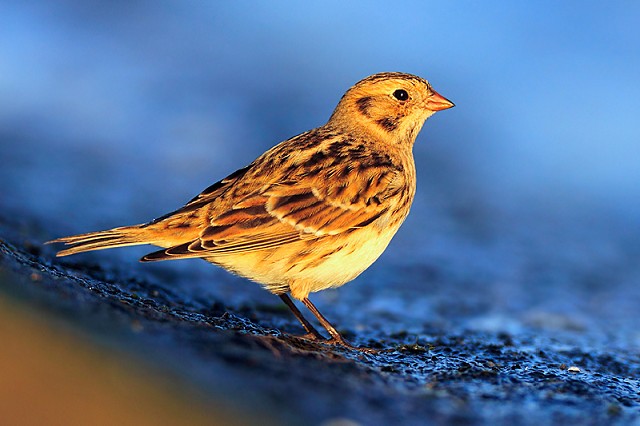
Lapland Bunting, Farmoor Reservoir, Oxfordshire (Photo: Nigel Forrow)

Gannet, Fife Ness, Fife (Photo: John Anderson)

Black-tailed Godwit, New Brighton, Cheshire (Photo: Richard Steel)

Buff-breasted Sandpiper, Portnaluchaig, Highland (Photo: Jim Duncan)

Whimbrel, Hilbre Island, Cheshire (Photo: Matt Thomas)

Donaldson-Smith's Sparrow-Weaver, Kenya (Photo: Richard Crossen)

